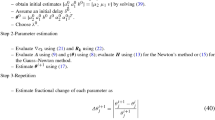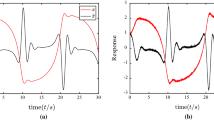Abstract
Compared with model approximation for general SISO transfer function models with or without a single constant delay, the approximation problem for SISO transfer function models with multiple delays has received much less attention. In this paper, we attack this problem and thus present a multiple-point step response fitting based approximation method to derive the reduced models. A simple frequency-domain weighted recursive least squares (RLS) algorithm is proposed to determine a set of parameters so that the reduced models can approximate the original models by minimizing the defined frequency-domain squared-error between the step responses of the original and the reduced model. Numerical examples have demonstrated that the proposed approximation approach can not only introduce less dynamic approximation error, but also yield zero steady-state error.
Similar content being viewed by others
References
C. L. Du, L. H. Xie, and Y. C. Soh, “H ∞ reducedorder approximation of 2-D digital filters,” IEEE Trans. Circuits Syst. I, vol. 48, no. 6, pp. 688–698, 2001.
D. J. Davison, “A method for simplifying linear dynamic systems,” IEEE Trans. Automat. Contr., vol. 11, no. 1, pp. 93–101, 1966.
D. C. Oh and E. T. Jeung, “Model reduction for the descriptor systems by linear matrix inequalities,” International Journal of Control, Automation, and Systems, vol. 8, no. 4, pp. 875–881, 2010.
A. H. Whitfield and N. G. Williams, “Integral leastsquares techniques for frequency domain model reduction,” Int. J. Systems Sci., vo1. 19, no. 8, pp. 1355–1371, 1988.
Y. Liu and B. D. O. Anderson, “Model reduction with time delay,” IEE Proc. D, vol. 134, no. 6, pp. 349–367, 1987.
C. Hwang and J. H. Hwang, “A new two-step iterative method for optimal reduction of linear SISO systems,” J. Franklin Institute, vol. 333, no. 5, pp. 631–645, 1996.
J. Wang, P. Houlis, V. Sceeram, and W. Liu, “Optimal model reduction of non-causal systems via least squares frequency fitting,” IET Control Theory and Applications, vol. 1, no. 4, pp. 968–974, 2007.
Z. J. Yang, T. Hachino, and T. Tsuji, “Model reduction with time delay combining the leastsquares method with the genetic algorithm,” IEE Proc. of Control Theory and Applications, vol. 143, no. 3, pp. 247–254, 1996.
S. Mukherjee, Satakshi, and R.C. Mittal, “Model Order reduction using response-matching technique,” J. Franklin Inst., vol. 342, no. 1, pp. 503–519, 2005.
S. L. Cheng and C. Hwang, “Optimal approximation of linear system by a differential evolution algorithm,” IEEE Trans. SMC-A, vol. 31, no. 6, pp. 697–707, 2001.
L. Wang, L.-L. Li, and F. Tang, “Optimal reduction of models using a hybrid search strategy,” Applied Mathematics and Computation, vol. 168, no. 2, pp. 1357–1369, 2005.
H. X. Li, J. S. Lu, and H. S. Yang, “Model reduction using the genetic algorithm and Routh approximation,” J. Syst. Eng. and Electro., vol. 16, no. 3, pp. 632–639, 2005.
Q. G. Wang, Y. Zhang, and M. S. Chiu, “Decoupling internal model control for multivariable systems with multiple time delays,” Chemical Engineering Science, vol. 57, no. 1, pp. 115–124, 2002.
T. Liu, W. D. Zhang, and F. R. Gao, “Analytical decoupling control strategy using a unity feedback control structure for MIMO processes with time delays,” J. Process Control, vol. 17, no. 2, pp. 173–186, 2007.
L. Han, J. Sheng, F. Ding, and Y. Shi, “Auxiliary model identification method for multirate multiinput systems based on least squares,” Mathematical and Computer Modeling, vol. 50, no. 7–8, pp. 1100–1106, 2009.
F. Ding, Y. Shi, and T. Chen, “Performance analysis of estimation algorithms of non-stationary ARMA processes,” IEEE Trans. on Signal Processing, vol. 54, no. 3, pp. 1041–1053, March 2006.
R. Pintelon, P. Guillaume, Y. Rolain, J. Schoukens, and H. Van hamme, “Parametric identification of transfer functions in the frequency domain-a survey,” IEEE Trans. Automat. Contr., vol. 39, no. 11, pp. 2245–2260, 1994.
Author information
Authors and Affiliations
Corresponding author
Additional information
Recommended by Editorial Board member Hamid Reza Karimi under the direction of Editor Myotaeg Lim.
This work was supported by the National Natural Science Foundation of China (61104084, 61004009), the Guangdong Education University-Industry Cooperation Projects (2010B090400410), the Fundamental Research Funds for the Central Universities of China (N090608001, N100408004).
Ping Zhou received his B.S. and M.S. degrees in Control Theory and Engineering from Northeastern University, Shenyang, China, in 2003 and 2006, respectively. His research interests include integrated plant control and systems, decoupling control, and softsensor.
Bo Xiang received his B.S. degree in Industrial Automation from Southwest University of Science and Technolgoy, Mianyang, China, in 1985. His research interests include process control, and industrial automation.
Jun Fu received his Ph.D. degree in Mechanical Engineering from Concordia University, Canada, in 2009. His research interests mainly lie in dynamic optimization, control of hysteretic systems, and robust control of nonlinear systems.
Tian-You Chai received his Ph.D. degree from Northeastern University, Shenyang, China, in 1987. Currently, he is a full professor and director of the State Key Lab. of Synthetical Automation of Process Industries (Northeastern University). His research interests include adaptive control, intelligent decoupling control, integrated plant control and systems, and the development of control technologies with applications to various industrial processes.
Rights and permissions
About this article
Cite this article
Zhou, P., Xiang, B., Fu, J. et al. Model approximation of multiple delay transfer function models using multiple-point step response fitting. Int. J. Control Autom. Syst. 10, 180–185 (2012). https://doi.org/10.1007/s12555-012-0121-2
Received:
Revised:
Accepted:
Published:
Issue Date:
DOI: https://doi.org/10.1007/s12555-012-0121-2




